Welcome to our comprehensive guide on Echinodorus Aflame! This stunning aquatic plant is the perfect choice for adding a vibrant color splash to your freshwater aquarium.
This guide provides all the information you need to grow and care for Echinodorus Aflame successfully in your planted tank.
From understanding its origins and characteristics to setting up the ideal environment and addressing common challenges, we’ve got you covered.
With its captivating red foliage, Echinodorus Aflame is a popular choice among aquarists.
Whether you’re a beginner or an experienced hobbyist, this plant is relatively easy to care for and can truly transform the aesthetics of your aquarium.
So, let’s dive in and discover the wonders of Echinodorus Aflame!
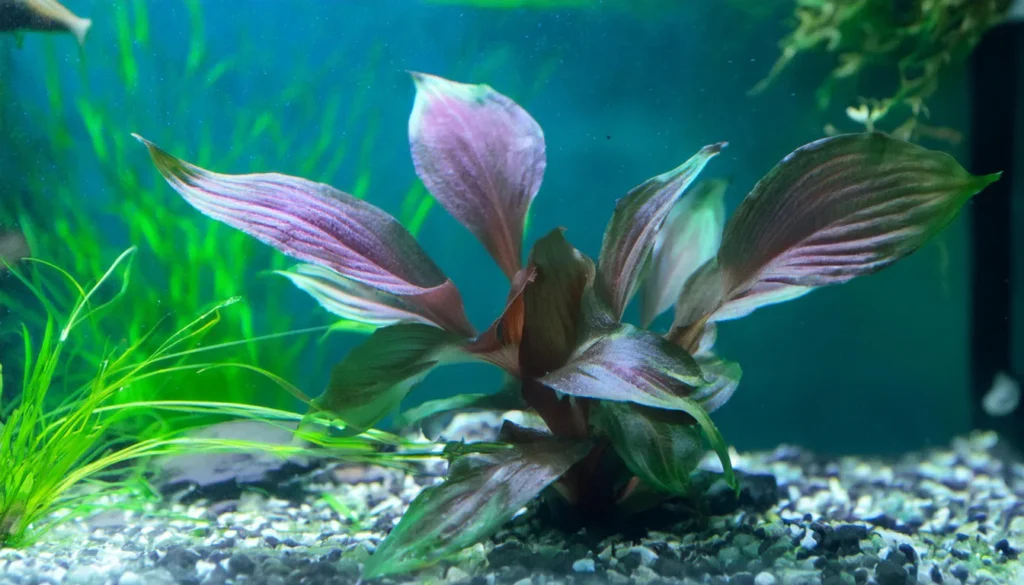
Key Takeaway
- Echinodorus Aflame is a vibrant aquatic plant that adds a colorful element to freshwater aquariums.
- Understanding the origins and characteristics of Echinodorus Aflame is essential for successful care and growth.
- Setting up the proper environment with the right substrate, lighting, and water parameters is crucial for the plant’s well-being.
- Nutrients and fertilization are vital in maintaining the vibrancy of Echinodorus Aflame’s foliage.
- Common challenges, such as the transition from emersed to submersed growth and dealing with pests and algae, can be effectively addressed.
Quick Stats
| Attribute | Details |
| Family Name | Alismataceae |
| Origin | Cultivar |
| Height | 20-30 cm (8-12 inches) |
| pH Range | 6.5 – 7.5 |
| CO2 Requirement | Low to Moderate |
| Growth Rate | Moderate |
| Care Level | Moderate |
| Color Form | Dark purple to black leaves |
| Water Conditions | 22-30°C (72-86°F), adaptable to a wide range of hardness |
| Max Size | Leaves can grow up to 30 cm (12 inches) in length |
| Lighting | Moderate to High |
| Supplements | Iron-rich fertilizers, CO2 supplementation can enhance coloration |
| Placement | Mid-ground to Background |
| Propagation | By adventitious shoots from the base or seeds |
What Is Echinodorus Aflame?
Echinodorus Aflame, also known as Echinodorus’ Aflame‘, is a small to medium-sized aquatic plant that features striking red foliage.
It is a cultivar that entered the trade around 2005 and is popular among aquarists for its vibrant color and manageable size.
The underwater leaves of Echinodorus Aflame display deep, dark red tones and add a captivating focal point to any freshwater aquarium.
Natural Habitat And Origin
Echinodorus Aflame, also known as the “Red Flame Sword,” is a hybrid sword plant cultivated for aquariums.
Its natural habitat and origin are not well documented since it is a cultivated hybrid rather than a species found in the wild.
However, it belongs to the genus Echinodorus, which primarily consists of aquatic plants native to the tropical regions of Central and South America.
These plants typically grow in marshy areas, along riverbanks, and in shallow waters with moderate to high light levels.
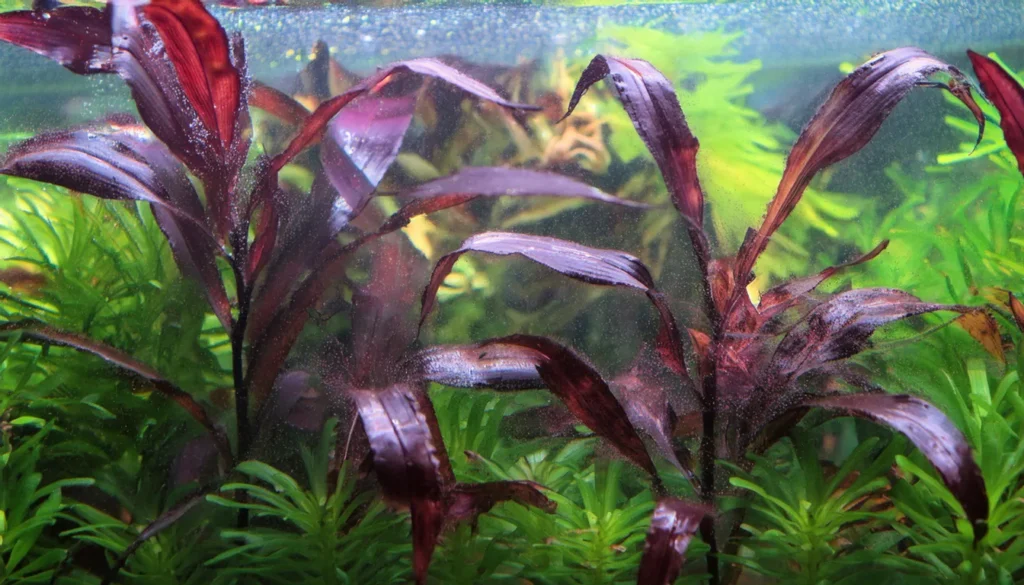
Physical Characteristic
- Echinodorus Aflame emerged on the market around 2005 and quickly captured the attention of aquascaping enthusiasts. With its radiant red coloration and compact size, this aquatic plant became a sought-after addition to planted tanks of various sizes. Its unique appearance and visual impact have made it a favorite among hobbyists looking to create stunning aquatic landscapes.
- Echinodorus Aflame’s defining features are at the heart of its appeal. The underwater leaves of this plant exhibit an elongated elliptic shape, adding a graceful touch to any aquarium.
- However, the brilliant, deep red color truly sets Echinodorus Aflame apart. These vibrant red leaves are slightly wavy and have subtly curved margins, creating a captivating visual display. When submerged in an aquarium, Echinodorus Aflame reaches an average height of about 20 cm, making it an ideal choice for foreground and midground placements.
The Importance Of Adequate Lighting
- Adequate lighting is crucial for the proper growth and vibrant coloration of Echinodorus Aflame.
- This plant requires strong-intensity lighting to enhance the intensity of its red foliage.
- Invest in high-quality LED or fluorescent lights with adjustable brightness settings.
- Place the lights above the aquarium, ensuring even light distribution throughout the tank.
Temperature Parameters For Robust Growth
- Moderate Temperatures: Echinodorus Aflame thrives in aquariums with temperatures ranging from 72°F to 82°F (22°C to 28°C). This moderate temperature range provides the ideal conditions for the plant’s growth and development.
- Stable Environment: Maintaining a stable temperature within this range is essential for the plant’s overall health and vigor. Sudden fluctuations or extremes in temperature can stress the plant, leading to stunted growth or other issues. Therefore, it’s crucial to monitor the aquarium temperature regularly and make adjustments as needed to keep it within the optimal range.

Maintaining The Water Parameters
- Echinodorus Aflame thrives in specific water parameters. For optimal growth, maintain the temperature range of 15-30°C.
- The pH level should be slightly acidic to neutral, ideally between 5 and 7, to create the ideal environment for this plant.
- Also, maintain moderate water hardness to maintain the plant’s health and well-being.
Substrate Requirement
- The substrate plays a vital role in providing essential nutrients for the growth of Echinodorus Aflame. It should be nutrient-rich and capable of retaining moisture.
- A combination of gravel and specialized aquatic plant substrate is recommended. The gravel provides stability and prevents the substrate from compacting, while the plant-specific substrate delivers important nutrients to nourish the roots of Echinodorus Aflame.
RELATED: Dwarf Chain Sword For A Lush Carpet In Your Aquascape
Positioning Your Echinodorus Aflame For Optimal Aesthetics
The placement of Echinodorus Aflame in your aquascape can greatly influence its overall impact and aesthetics.
Consider these placement ideas to maximize the visual appeal of this vibrant plant:
- Midground: Position Echinodorus Aflame in the midground of your aquarium. Its colorful foliage will create a captivating focal point that draws the viewer’s attention.
- Background: Alternatively, you can use Echinodorus Aflame as a solitary plant in the background of your aquascape. This placement creates a bold statement and adds depth to the overall composition.
Recommended Tank Size
- Consider Tank Dimensions: While a minimum tank size of 20 gallons is recommended, it’s also crucial to consider the dimensions of the tank. Echinodorus Aflame can grow quite tall and wide, so a tank with ample width and height provides better opportunities for the plant to flourish without overcrowding.
- Room for Growth: Larger tanks offer more room for the plant to spread out and develop its root system, which contributes to its overall health and stability. Additionally, a spacious tank allows for better water circulation and distribution of nutrients, which are essential for the plant’s growth.
- Aquascape Design: The recommended tank size also depends on your aquascape design and the other inhabitants of the tank. If you plan to include other plants or fish species, a larger tank provides more flexibility in creating a balanced and visually appealing underwater environment.
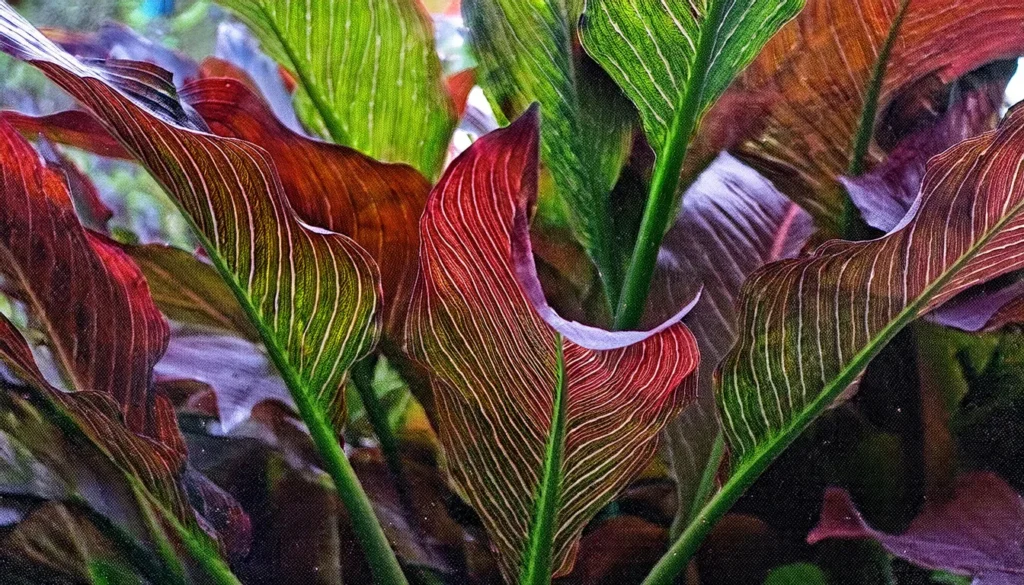
Suitable Tank Mates For Echinodorus Aflame
- Peaceful Community Fish: Opt for peaceful community fish species that won’t uproot or damage the Echinodorus Aflame. Examples include tetras, rasboras, gouramis, and some species of corydoras catfish. These fish tend to occupy different levels of the tank and won’t compete directly with the plant for space or resources.
- Bottom Dwellers: Consider adding bottom-dwelling fish like dwarf corydoras or otocinclus catfish. These species help keep the substrate clean and can coexist well with Echinodorus Aflame without causing damage to the plant.
- Shrimp and Snails: Dwarf shrimp species such as cherry shrimp or amano shrimp, as well as peaceful snails like nerite snails or Malaysian trumpet snails, can make excellent tank mates. They contribute to the ecosystem by scavenging algae and organic debris while posing minimal risk to the Echinodorus Aflame.
- Avoid Digging Species: Steer clear of fish species known for digging or rooting around in the substrate, as they can disturb the roots of the Echinodorus Aflame. This includes certain species of cichlids, loaches, and some larger catfish.
Nutritional Needs Of The Plant
Micro Nutrients
- Iron (Fe): Crucial for chlorophyll production, iron deficiency can lead to yellowing of leaves. Use iron-rich fertilizers or substrates to ensure proper growth.
- Zinc (Zn): Essential for enzyme activation and protein synthesis, zinc deficiency can cause stunted growth and distorted leaves.
- Manganese (Mn): Required for photosynthesis and enzyme activation, manganese deficiency manifests as yellowing between leaf veins.
- Copper (Cu): Necessary for enzyme function and electron transport, copper deficiency can lead to wilting and poor growth.
- Molybdenum (Mo): Facilitates nitrogen fixation and enzyme activity, molybdenum deficiency results in yellowing and poor growth.
Macro Nutrients
- Nitrogen (N): Vital for vegetative growth and protein synthesis, nitrogen deficiency causes yellowing and slow growth.
- Phosphorus (P): Critical for energy transfer and root development, phosphorus deficiency results in dark green or purple leaves and stunted growth.
- Potassium (K): Supports water and nutrient uptake, as well as overall plant health. Potassium deficiency can cause yellowing and necrosis of older leaves.
- Calcium (Ca): Strengthens cell walls and aids in nutrient transport, calcium deficiency leads to distorted growth and weakened stems.
- Magnesium (Mg): Essential for chlorophyll production and enzyme activation, magnesium deficiency causes yellowing between leaf veins.
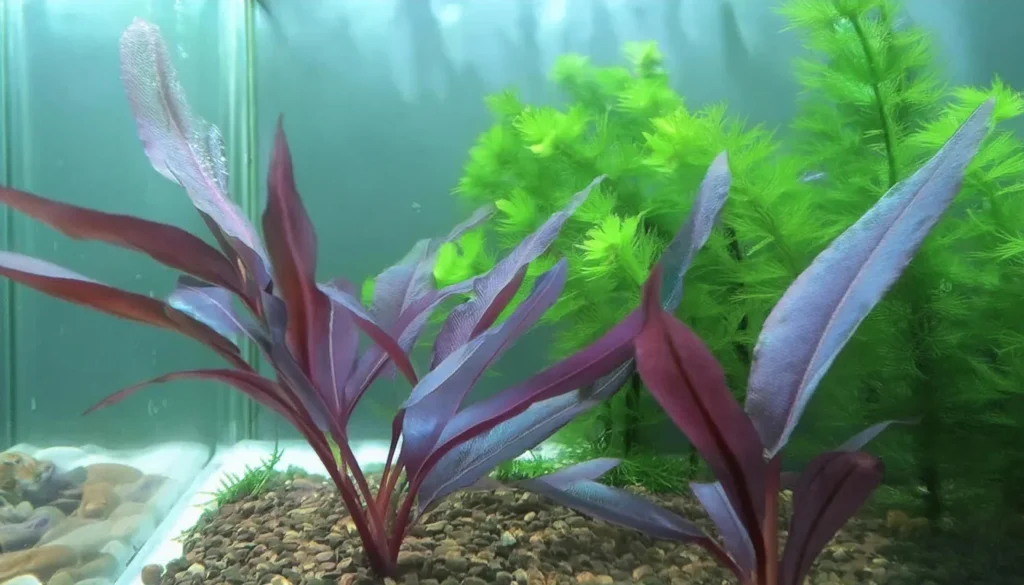
Cultivating Echinodorus Aflame At Home
- Substrate Preparation: Use nutrient-rich substrate to provide a solid foundation for the plant’s roots. Ensure the substrate is deep enough to anchor the plant securely.
- Lighting Setup: Install adequate lighting, preferably full-spectrum LEDs, to promote photosynthesis and healthy growth. Aim for around 8-10 hours of light per day.
- Water Quality: Maintain optimal water parameters, including temperature (around 72-82°F or 22-28°C), pH (6.5-7.5), and hardness (soft to moderately hard), to mimic the plant’s natural habitat.
RELATED: A Comprehensive Guide To Planting Cryptocoryne Wendtii Tropica
Planting
- Selecting Healthy Specimens: Choose healthy Echinodorus Aflame specimens with vibrant foliage and firm roots. Avoid plants with yellowing or damaged leaves.
- Planting Technique: Gently remove the plant from its pot and carefully separate the roots. Plant each specimen into the substrate, ensuring the roots are well-covered but the crown remains above the substrate level.
- Spacing: Allow sufficient spacing between each plant to accommodate their mature size and prevent overcrowding, typically 6-8 inches apart.
Initial Care
- Watering: Initially, water the plants generously to help them establish their roots. Subsequently, maintain a regular watering schedule, ensuring the substrate remains moist but not waterlogged.
- Fertilization: Supplement with a comprehensive liquid fertilizer or root tabs to provide essential nutrients for robust growth. Follow the manufacturer’s instructions for dosage and frequency.
- Pruning and Maintenance: Trim any damaged or yellowing leaves regularly to maintain the plant’s overall health and aesthetics. Monitor for signs of nutrient deficiencies or pest infestations and take appropriate action promptly.
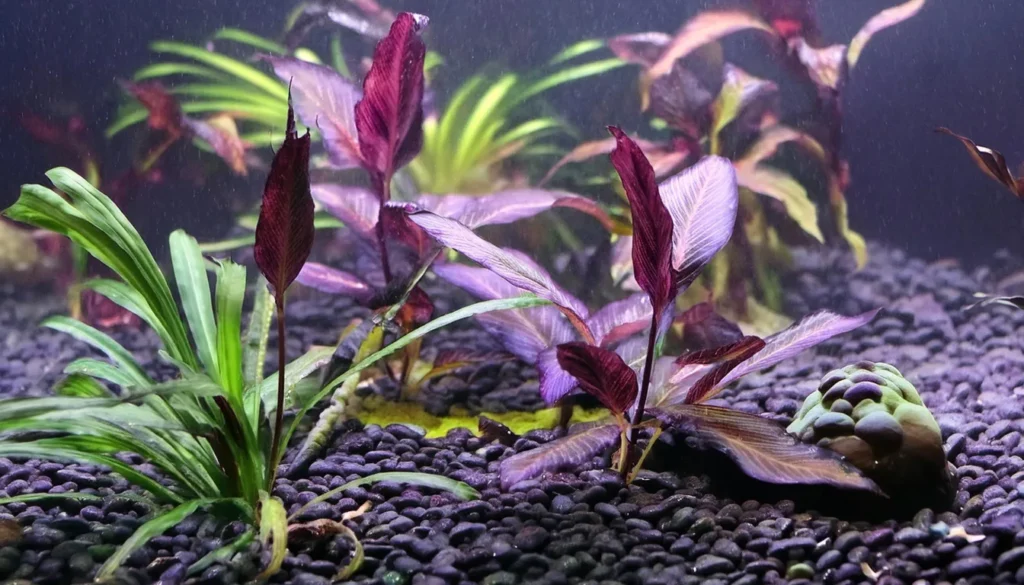
Vegetative Propagation Techniques Of Echinodorus Aflame
- Echinodorus Aflame can be propagated using division and rhizome separation methods. Division involves separating the plant into smaller sections, each with its own root system.
- Carefully remove the plant from the substrate and gently separate the offshoots using clean tools. Ensure that each section has enough roots to support growth.
- Plant the divided sections in suitable substrate, providing adequate light and water conditions for their development.
- Rhizome separation is another propagation technique for Echinodorus Aflame. The rhizome is a horizontal stem that produces offshoots and roots.
- To propagate through rhizome separation, carefully remove the plant from the substrate and locate the rhizome.
- Gently separate the offshoots from the main rhizome, taking care not to damage the roots. Plant the separated offshoots in the appropriate substrate and provide optimal conditions for their growth.
Benefits Of Planting Echinodorus Aflame
- Natural Aesthetic Appeal: Echinodorus Aflame adds a visually striking element to the aquarium with its vibrant red and green foliage, enhancing the overall aesthetics and creating a captivating focal point.
- Oxygenation and Filtration: Like other aquatic plants, Echinodorus Aflame contributes to oxygenation of the water through photosynthesis, promoting a healthier environment for fish and other aquatic inhabitants. Additionally, the plant helps to naturally filter the water by absorbing excess nutrients and pollutants.
- Aquascape Design: With its unique leaf shape and coloration, Echinodorus Aflame offers versatility in aquascape design, allowing aquarists to create stunning underwater landscapes and showcase their creativity.
- Shelter and Security: The dense foliage of Echinodorus Aflame provides shelter and hiding places for fish and invertebrates, helping to reduce stress and aggression among tank inhabitants. This can be particularly beneficial for shy or territorial species.
- Algae Control: By competing with algae for nutrients and light, Echinodorus Aflame can help prevent the overgrowth of nuisance algae in the aquarium, leading to a cleaner and more balanced ecosystem.
- Natural Behavior Stimulus: Many fish species exhibit natural behaviors such as foraging and grazing among aquatic plants like Echinodorus Aflame. The presence of live plants can stimulate these behaviors, promoting the overall well-being and natural behaviors of fish in captivity.

Conclusion
Echinodorus Aflame is a truly remarkable aquatic plant that brings vibrant color and visual appeal to any freshwater tank. Understanding its origins and unique characteristics can provide the ideal conditions for this plant to thrive in our aquariums.
With the right setup and care, we can enjoy its captivating beauty.
Throughout this comprehensive guide, we have learned about the origins and advent of Echinodorus Aflame in aquascaping and its defining features, such as its striking red color, shape, and size.
We have explored the key factors in setting up an aquarium for Echinodorus Aflame, including choosing the right substrate, providing proper lighting, and maintaining suitable water parameters.
We have also discussed the importance of nutrients and fertilization in feeding this vibrant plant and common challenges that may arise, such as the transition from emersed to submersed growth and addressing pests and algae.
Furthermore, we have explored various aquascaping ideas and placement techniques to accentuate the beauty of Echinodorus Aflame in our aquariums.
Frequently Asked Question
How Can I Enhance The Deep Purple Coloration Of Echinodorus’ aflame’ Leaves?
To maximize the vibrant purple coloration of Echinodorus’ Aflame’, provide high-intensity lighting and supplement with iron and potassium. The plant’s color can become more pronounced under stress, such as slightly higher temperatures or increased lighting intensity.
However, ensure these conditions do not harm the plant or other tank inhabitants. Additionally, CO2 supplementation can improve overall health and color vibrancy.
What Specific Substrate Composition Benefits Echinodorus ‘aflame’ The Most For Root Development And Nutrient Uptake?
Echinodorus’ Aflame’ thrives in a nutrient-rich substrate with a fine to medium grain size for easy root penetration.
A layered substrate system, with a bottom layer of organic-rich aquatic soil capped with gravel or sand, provides an ideal environment for root development and nutrient uptake.
Incorporating laterite or clay in the substrate can enhance iron availability, supporting leaf coloration and growth.
Can Echinodorus’ aflame’ Adapt To Emersed Growth Conditions, And What Are The Benefits?
Yes, Echinodorus’ Aflame’ can adapt to emersed growth conditions, where its leaves grow above water.
This adaptation can lead to more robust growth, enhanced flowering, and potentially more intense leaf coloration due to direct exposure to air and light.
Emersed cultivation can also facilitate propagation, as flowers and seeds develop more readily in these conditions. Ensure high humidity and consistent moisture in the soil to support emersed growth.
How Should I Manage The Transition Of Echinodorus ‘aflame’ From Emersed To Submerged Conditions To Minimize Shock?
Gradually acclimate Echinodorus’ Aflame’ when transitioning from emersed to submerged conditions to minimize shock.
Begin by incrementally increasing water depth around the plant over several days or weeks, allowing the plant to adjust to the change in water pressure and gas exchange rates.
Adequate lighting and CO2 supplementation during the transition can support photosynthesis and reduce stress. Keep water parameters stable and monitor the plant for signs of stress or decay, trimming affected areas as needed.
What Advanced Techniques Can Be Used To Propagate Echinodorus ‘aflame’ Efficiently In A Home Aquarium?
Echinodorus’ Aflame’ can be advanced through seed collection and germination or by separating adventitious plants from the flower stalk.
To propagate by seeds, allow flowers to pollinate and produce seed pods emerged, then collect and sow the seeds in a moist substrate under high humidity and light conditions.
For adventitious plants, wait until they develop roots and a few leaves before carefully separating them from the parent stalk and planting them on the substrate.
Both methods require patience and careful attention to environmental conditions to ensure successful growth.
- Unveiling The Wonders Of Riccia Fluitans In Aquascapes - August 7, 2024
- Vallisneria Gigantea Var. Guide To Care And Cultivation At Home - July 31, 2024
- Vesicularia Dubyana Care & Growth Guide Tips For Beginner Gardeners - July 30, 2024
